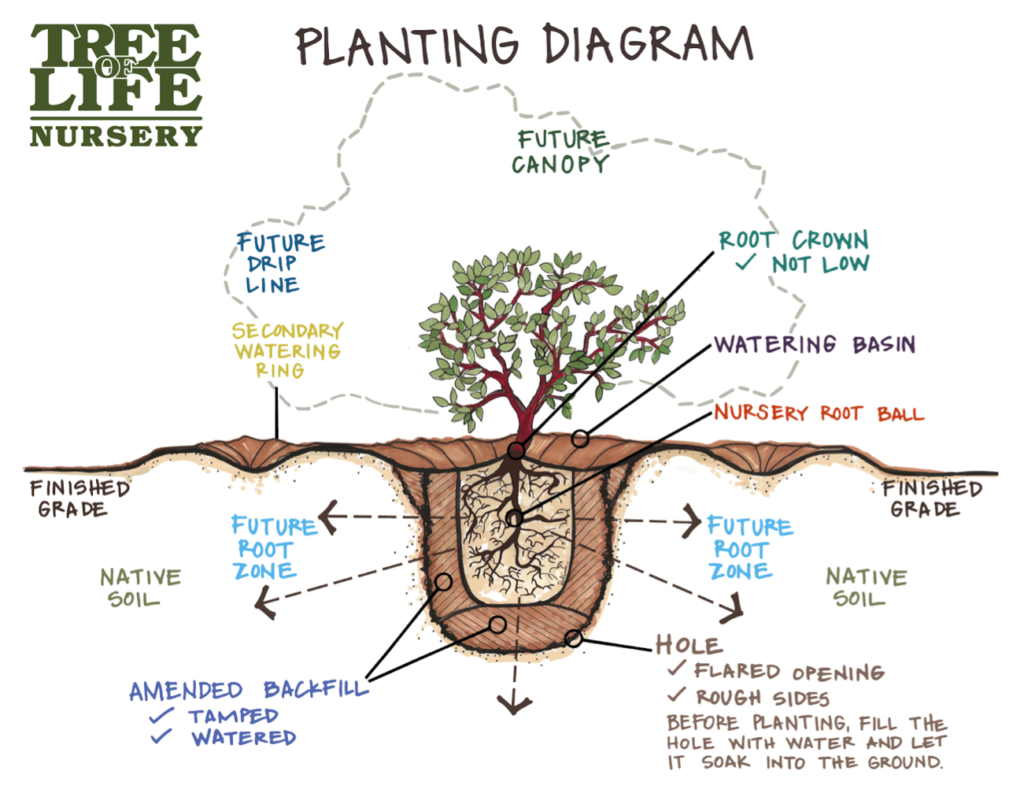California Native Planting Guide

Instructions for Planting and Care:
Your native plants are in top condition and ready to plant. Like all nursery stock, these plants when brought into the landscape, need careful attention during their establishment period
Ten Easy Steps for Success
1. Dig hole at least* as deep and twice as wide as plant container. Break up large clods and try to avoid the smooth-sided “bathtub” effect in the hole.
2. Soil Amendment:
- For many landscape and revegetation jobs, no soil amendment is recommended for native plants. The native soil should be soft and friable. Eliminate large rocks and clods from your backfill soil.
- For landscape soils requiring amendment, use approximately 1/3 composted or nitrolized forest humus to 2/3 native soil, blending them in a pile outside the hole. This is your backfill mix.
- Slow release fertilizer granules or tabs may be incorporated with the backfill, or placed in the bottom of the hole. If tabs are used, make sure they are not touching the root ball. Most native plants are able to find nutrients even in poor soils. If a pre-plant fertilizer is used, application rates should be lower than those used for general landscape ornamentals.
3. Fill planting hole with water and allow to percolate (drain) into subsoil.
4. Spill some backfill material into the bottom of hole, moisten, tamp and mound slightly.
5. Set plant root ball atop the moistened backfill so that plant collar is 1″ higher than finished grade.
6. With water flowing slowly from a hose into the hole, replace backfill material up to about 2/3 the height of the root ball; moistening, tamping and settling all around.
7. Fill remaining portion surrounding the top of root ball with more backfill. Be sure collar is still higher than grade.
8. Create an irrigation basin berm, considerably outside the dimension of the hole using remaining backfill and native soil.
9. Apply a generous portion (approx. 2-4″ deep) coarse, organic weed and disease-free mulch; topdressing around exposed collar and inside the entire basin area.
10. Irrigate thoroughly, filling the basin with water and sprinkling around to settle backfill, mulch and berm.
Allow to soak in and repeat.
Congratulations for using “Hort-sense” with your planting!
Notes for Warm Season Planting and Watering:
1. Summer is the most difficult season to install native plants in the landscape (for best results, wait until fall through early spring).
2. Pre-irrigate the planting hole and allow to drain.
3. Carefully follow the planting instructions above.
4. Upon completion, apply 2-4 inches of organic mulch around the root zone of each plant (away from the crown).
5. Avoid watering during the heat of the day, and avoid overhead watering; prolonged leaf wetting can promote disease.
6. Provide temporary shade to the most sensitive species to reduce the stress of exposure to direct sun.
7. Do not allow the root ball to dry out; water 1-3 times a week by thoroughly soaking the soil. Infrequent, deep soaking is preferable to short, frequent waterings.
Initial Maintenance
Like all nursery stock, container-grown California native plants need careful attention during their establishment period in the landscape.
WATERING – It is important that the root ball does not dry out during the first two or three months. Irrigate about once a week, trying not to oversoak the surrounding soil. After two months, be sure to water deeply. Do not allow the ground to remain soggy for long periods of time, as this encourages disease, especially during the dry season. Native plants need deep moisture and cool roots to find oxygen. Usually, one deep watering every two or three weeks is sufficient in summer and fall. Less frequent irrigations are required in the spring. During the winter, rainfall alone is adequate for most plantings. Avoid overhead watering during the hot part of the day in the warm season.
MULCHING – “Water in the bank” in the plant’s water economy. Use organic mulch in late spring and fall to retain moisture, cool roots, discourage weeds and strengthen plants.
FERTILIZING – Use “all purpose” type plant foods for cool season feedings (Oct. – May). One light application mid-summer. Usually, you can cut the rates given for general ornamental plants in half.
PRUNING – Depending on the type of plant, you will need to thin and “head back”, to direct growth of the maturing plant. Remove any dead wood. Use sanitation procedures when pruning diseased branches.
TROUBLESHOOTING – Insect, disease, weed, pest or cultural problems? Please feel free to call us at the nursery.
Generally speaking, thin the plants in early summer and mulch, start feeding in the fall and mulch again. Head back branch tips as needed in winter and spring. Irrigate wisely during the warm season. Native plants need love too.